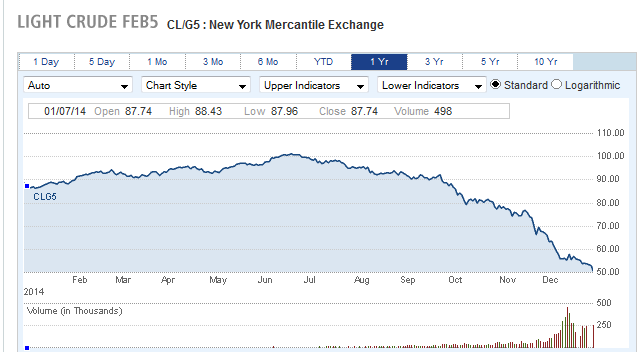Time to Reallocate Your Portfolio?
Let’s Evaluate the Markets
As we head into 2016, many of our clients are wondering how to properly position their investments to protect value and maximize profits. In order to make this assessment, it’s best to take a broad look at market performance over the course of several years. This allows us to gain a better understanding of where the best long-term values are and identify areas we may want to exercise caution.
Over the past few years, there has undoubtedly been a strong up-trend in global equity market values and a retracement in precious metals.
The table below shows the performance of U.S. stocks and precious metals since 2000 as well as breaks down the returns in each sector.

There are some who argue the U.S. economy has truly recovered from the calamity of 2007 and 2008 and that’s the real reason for the stock market gains over the past few years. Others, however, feel that stocks have risen as a direct result of the Fed’s Quantitative Easing (QE), flooding markets with liquidity and free money.
The question that remains is whether or not this economy, so dependent upon economic stimulus and historically low interest rates, can thrive without the continuation of historic levels of Fed intervention.
So, just how much debt have we accumulated as a result of these monetary policies? The answer may shock you when you look at the hard facts.
Even after the recent correction, gold and silver remain some of the best performers of any asset class so far this century. There is still room for further gains, however, as gold increased over 2,400% and silver by 3,600% in the 1970s.
Let’s Look Under the Surface
In December of 2008, the U.S. government had 10.9 trillion dollars in national debt. In December of 2014, the national debt has exploded to over $18 Trillion (a 70% increase in 6 years) with unfunded liabilities like social security and medicare exceeding $115 Trillion!
It’s painfully obvious this trend is not reversing. In fact, the last time the U.S. debt actually decreased from one fiscal year to the next was back in 1957 during the Eisenhower administration. Keep in mind it took over 205 years for the U.S. to rack up its first Trillion in debt. Five years later, we were two trillion in the hole. The latest trillion took only 403 days to accumulate—just over a year. Far from reversing, our accumulation of debt is accelerating at a rapid rate.
This harsh reality suggests that we are not out of the woods. History has proven time and time again that surging debt is a serious problem and issuing more debt to pay off old debt, in every instance, has a disastrous outcome.
To many, this number isn’t important so long as the stock market is rising and retirement accounts are appreciating. To others it poses a major cause of concern going forward.
 Very recently, Bill Gross, Janus Capital portfolio manager and Pimco founder, addressed this issue in a letter to investors. Here is an excerpt:
Very recently, Bill Gross, Janus Capital portfolio manager and Pimco founder, addressed this issue in a letter to investors. Here is an excerpt:
“Each of these central bankers is trying to achieve the same basic objective: Solve a debt crisis by creating more debt. In the U.S., as elsewhere, there has been little focus on public investment and infrastructure spending. It’s been all monetary policy, all of the time, with most of the positives flowing over to markets as opposed to the real economy. The debt currently being created is not promoting real growth and solving a debt crisis—it is being used by corporations to repurchase shares and accentuate the growing inequality between the very rich and the middle class.”
This is a dire message from one of the most famous investors of all time. One would hope that the $7 Trillion in debt issued under the recent administration would eventually trickle down to main street, but it’s undeniable that most of that money has stayed on Wall Street. This is exactly what Mr. Gross refers to in his writings, and we believe this is cause for concern when assessing the recent run-up in the stock market and planning for the next few years.
Falling Oil Prices: A Double-Edged Sword?
The shale oil boom in the United States has had a hugely positive impact on the overall economic health of the country. Not only has it greatly impacted corporate earnings, but it elevates our GDP and most importantly, creates an enormous amount of high-paying jobs.
It is hard to overstate the importance of the shale boom. Thanks to the boom, we are now the largest oil producer on the planet, producing more than Russia or Saudi Arabia. This is exactly the type of activity we need for a genuine long-term economic recovery.

After topping $100 a barrel this past summer, the price of oil has fallen precipitously.
The falling price of oil is a huge benefit to the financial health of the consumer and the overall economy. But could the sudden drop in oil be a major cause for concern, for more important reasons?
Michael Snyder of The Economic Collapse blog believes so. In a recent article he mentions that there has only been one other time in history when the price of oil has crashed by more than $40 in less than six months--during the second half of 2008 just before the great financial collapse.
Another concern is that the Organization of the Petroleum Exporting Countries has now engaged in a price war with U.S. oil producers. It’s very inexpensive to produce oil in places like Saudi Arabia and Kuwait and more costly to extract oil from shale formations in Texas and North Dakota. Problems could arise if oil prices stay low or continue to fall, some U.S. producers could become unprofitable and go out of business.
Oil extraction from shale is a highly levered and costly process. Legendary oil man T. Boone Pickens feels that Saudi Arabia is in a stand-off with U.S. oil drillers to, as he put it, “see how the shale boys are going to stand up to a cheaper price.”
The bottom line is that the energy sector has been one of the only real bright spots for the domestic economy the past 10 years. If this sector starts to decline, it will undoubtedly have a major impact on our economic outlook and cost us an awful lot of good jobs.
Most would expect the falling price of oil to have an immediate and negative impact on precious metals prices. The reality, however, is quite the opposite and has come as a big surprise to many analysts.

Are Falling Oil Prices Hurting Gold?
There have been three primary reasons for the precious metals sell-off the past few years. The first has been the high rate of return from the stock market. Secondly, there is a feeling that the domestic economy is improving, and will continue to improve. Third, and most recently, there has been a surge in the strength in the U.S. Dollar compared to other global currencies like the Yen, Ruble, Euro, and British Pound.
Despite our own issues the Dollar is seen as a safe haven and a lesser evil when compared to the greater economic trouble in other parts of the world. As one of our clients recently put it, “the dollar is the cleanest of the dirty shirts in the hamper”.
The question remains: are these three data points a long-term trend or are markets in a euphoric high from never before seen fiscal stimulus from the Fed?
In 2011 gold set an all-time high of $1,900 while silver nearly reached its all-time high of $50 per ounce. Since that time, both metals have steadily declined to today’s levels with gold around $1,200 per ounce and silver around $17, a loss of 37% and 65%, respectively, from their 2011 highs.
Even with this correction, it’s important to understand that both gold and silver have held up beautifully in the face of record highs for the stock market. Notably, even as the price of oil plummeted in the fourth quarter of 2014, precious metals actually moved in the opposite direction and appreciated in value.
Warning from Bank of International Settlements
The Bank of International Settlements, considered by many to be the banking hub for central banks, warned of market fragility despite the bullish mood. Claudio Borio, the head of the BIS monetary and economic department, expressed concerns about events in mid-October when stock prices fell sharply and U.S. Treasury bonds were “exceptionally volatile”, even more so than at the height of the crisis triggered by the collapse of Lehman Brothers in 2008. “And yet”, he said, “just a few days later the previous apparent calm had returned.” He added, “To my mind, these events underline the fragility—dare I say growing fragility—hidden beneath the markets’ buoyancy.”
Walking the Financial Tightrope
The amount of data that comes at us each and every day is seemingly causing many to miss the forest for the trees. So, instead of focusing on weekly jobless claims or retail sales during the holidays, let’s refresh our memories on some time-tested truths about precious metals.
History shows that the value of gold falls when:
- - Inflation is low or falling and currencies are stable or rising
- - Overall economy is healthy
- - There is a peaceful global environment
- - Stock and bond yields are high enough to compensate for risk
On the other hand, gold rises in value when:
- - Inflation is high or rising and currencies are weakening
- - There is turbulence in financial markets
- - There is an unforeseen, black-swan event
- - Global geopolitical tensions are rising
While we are not yet officially calling a bottom in precious metals, it’s obvious that many of the issues outlined in this report are very important to consider. In fact, given the unprecedented national and global debt levels, one could argue that the fundamentals have never been more attractive, particularly if you’re investing with a long-term horizon in mind.
Should the U.S. economy show signs of weakness or the value of the Dollar fall, it’s very likely that both gold and silver will appreciate in value. At current levels, there is over 50% upside in gold in relation to all-time highs and 185% upside in silver, just to return to 2011 highs.
Not only do both metals currently offer great long-term value and upside potential, but ownership of physical gold and silver offers you a level of financial security and privacy you won’t find in other asset classes today. The idea of taking a portion of wealth “off the grid” remains very attractive to our clientele and just makes good sense in these uncharted financial territories.
Our Recommendation for 2016: Steady Accumulation
Given the recent volatility in markets, we suggest a steady accumulation of precious metals in the coming months. This time tested and proven approach allows you to take advantage of potential market fluctuations as opposed to investing all at once.
If you’ve been buying metals for the past 10 years, then this is a perfect time to add to your holdings as current prices are far more attractive than they were in 2011/12. If you have only been in the market for the past few years, then you must use this opportunity to average down your positions and increase your holdings at lower levels.
The important thing to remember is that the fundamentals for higher gold and silver prices are very much in place. One thing we’ve learned from the stock market crash of 2008 is that financial catastrophe can strike when you least expect it. The key is to accumulate metals while they are out of favor instead of buying at all-time highs.








